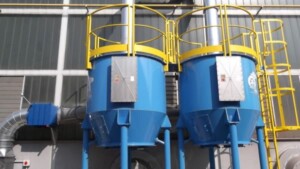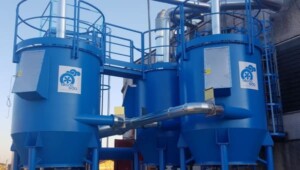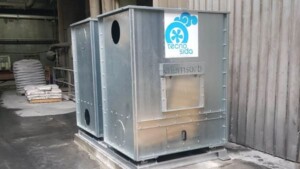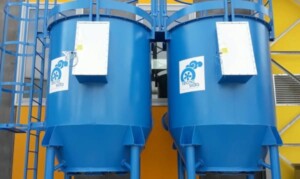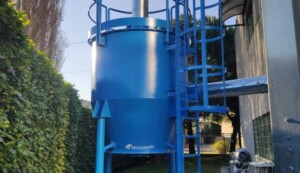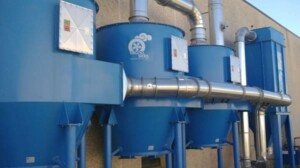Activated carbon filter for VOCs and solvents – CHEMSORB®
Activated Carbon filters for Volatile Organic Compounds, solvents and odours
Activated carbon filter: operating principles
The term “activated” is used to refer to carbons which have undergone an activation treatment; this treatment gives them exceptional porosity, resulting in a high adsorption capacity.
This phenomenon is caused by the existence of bonds of electrostatic nature and it occurs after the gas stream passes through the filter beds in the carbon filter Chemsorb®: this drastically reduces the concentration of polluting molecules in the air flow to be treated.
The adsorption efficiency depends on many factors, the main of which are:
- relative humidity;
- temperature;
- speed at which the stream passes through the filter;
- activated carbon type and surface area;
- molecular weight, boiling point and concentration of the substance to be filtered;
- nature of the pollutant.
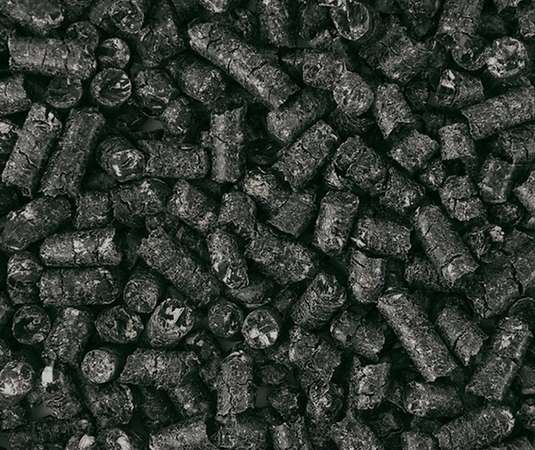
The nature of the pollutant is the feature that most influences the adsorption capacity of the activated carbon. In fact, depending on their nature and chemical characteristics, pollutants may be highly adsorbable (benzene, paraffin, fumes…), moderately adsorbable (chlorine, acetone, ethylene…) or poorly adsorbable (propane, ammonia…). In addition, it must be considered that all ketones, and to a lesser extent alcohols and acids, give rise to self-combustion problems, so the carbons must be provided with measuring and protection systems. The quantity and quality of the adsorbent material actually used depends on the concentration and type of the solvents (VOCs) to be treated. The use of common activated carbon is recommended for temperatures up to a maximum of 50-60 °C. To prevent a rapid saturation of the activated carbon, it is necessary to work with a relative humidity which is lower than 60%.
According to the degree of retentivity of this material and of the product design parameters, the typical efficiency of a Chemsorb® activated carbon filter can be up to 95%.
Tecnosida® designs Chemsorb® carbon filters on the basis of the data you provide, in order to develop an ad hoc, efficient system that maximises the degree of retentivity of the substance to be treated.
Available models for the Chemsorb® activated carbon filter
Tecnosida® offers both circular and rectangular section models. The circular type involves the welding of sheet metal elements and carbon steel profiles, which are calendered and painted, and it has supporting legs. The rectangular type is made up of press-folded galvanised sheet metal panels, which are assembled and bolted together. The two models can be manufactured using different materials.
These manufacturing methods make it easy to extend the abatement system even after installation. Chemsorb® carbon filter is manufactured to simplify and reduce the operations required to replace the spent carbon with new refills. These systems are therefore very simple to manage both in their operation and in their planned maintenance.
| RECTANGULAR FILTER WITH HORIZONTAL BED | CIRCULAR FILTER WITH VERTICAL CARTRIDGES | |
| Flow rate m3/h | 500 to 2.000 | 2.000 to 8.000 |
| Quantity of carbon | 500 and over | 1.000 to 1.500 |
| Dimensions | 1.500 x 1.100h. 1.900 mm | 1.900 x h. 4.000 mm |
Advantages of the Chemsorb® activated carbon filters
The Chemsorb®:
- is scalable and can be designed with a circular or rectangular section according to your needs. These manufacturing methods make it easy to extend the abatement system even after installation;
- is manufactured using carbon steel, polypropylene, stainless steel or other materials depending on the application needs;
- is simple to use and its maintenance is easy to manage and to carry out;
- is equipped with measuring instruments that allow constant verification of the degree of carbon saturation;
- may be used to filter a wide range of gaseous pollutants;
- is designed in accordance with the best available technology (BAT).
Applications of the Chemsorb® activated carbon filters
Over the years, we have manufactured activated carbon filters for the abatement of VOCs in different contexts. They include:
- Printing, painting, impregnation, spreading, resin coating, adhesive coating, laminating, pad printing and lithography operations of substrates of different types with solvent-based products;
- Reactor loading operations in the pharmaceutical sector;
- Production of chemical agents involving the emission of solvent vapours;
- Production of varnishes, methacrylates, glues, adhesives, paints and/or similar products with solvents;
- Processing of synthetic polymers for the production of food packaging;
- Other processes with VOC emissions.
Chemsorb® applications
Ideal for all production processes and for specific applications that generate emissions containing VOCs, such as:
- Dry cleaning with VOCs (volatile organic compounds) or COCs (chlorinated organic compounds);
- Printing, painting, impregnation, glue spreading, resin coating, laminating, pad printing and lithography of various substrates with solvent-based products;
- Production of paints, glues, adhesives and/or related products with solvents;
- Other processes with VOC emissions.
Available options for the Chemsorb® activated carbon filter
Chemsorb® activated carbon filter: maintenance
Tecnosida® also plans regular ordinary and extraordinary maintenance to verify the structure of the system. This service is carried out by qualified personnel and it ensures:
- proper functioning of the filter;
- high pollutant filtration efficiency;
- waste reduction (both in economic and energy terms).
For further information, do not hesitate to contact us: we will plan this important activity with you!
